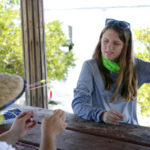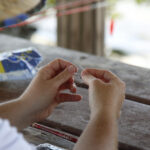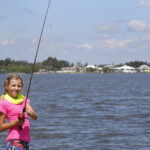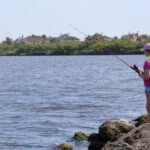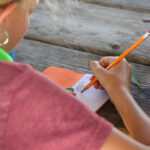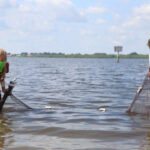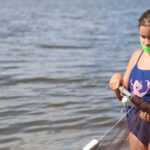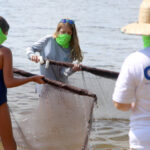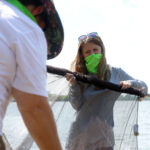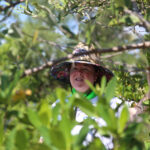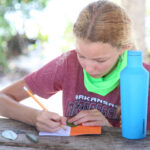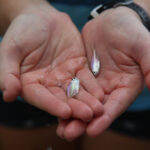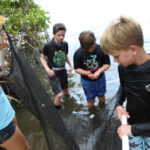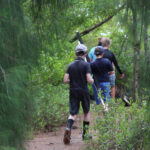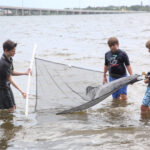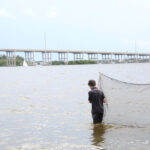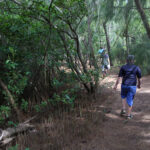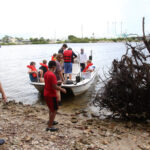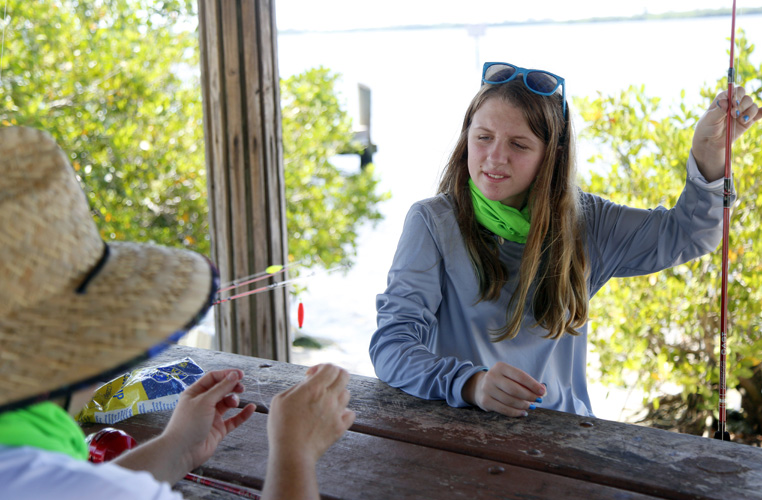
Young scientists immersed themselves in learning about the significance of the Indian River Lagoon this summer during one of two Lagoon Guardians Summer Camps offered by the Ocean Research & Conservation Association.
The week-long camps were a continuation of a school program that offers students an opportunity to get their hands wet through practical research experiences focused on the lagoon. Both programs engage middle school students in scientific research, citizen science and scientific literacy. During the school year, students from four local middle schools meet after school and participate in a field or lab component one Saturday a month.
The camp and afterschool programs are funded by a grant from the Indian River County Children’s Services Advisory Committee.
“This is an extension of the afterschool program,” explained Melissa McIntyre, ORCA educator. “The goal is to create better environmental stewardship surrounding the Indian River Lagoon in the next generation of citizen scientists.”
Because of the pandemic, the number of students attending the camps was reduced, temperatures and exposure screenings were conducted each morning, and neck gaiters were handed out in lieu of T-shirts, doubling as face coverings and sun protection. Additionally, activities at outdoor venues were optimized for social distancing, and family and social groups were encouraged to limit exposure potential.
“Our goal is to keep everybody safe and healthy, but also to have an opportunity to do some hands-on research. It’s not the type of activity you can do virtually. It misses a lot without being physically present in the environment,” explained McIntyre.
McIntyre said she had been surprised to discover how many local students had never even been to the lagoon, adding that she hopes they all walk away with an appreciation for its importance.
The students, whose expertise ranged from newcomers to experienced anglers, kicked off the week fishing and seining along the Wabasso Causeway. Those fish that met size and species regulations were kept for testing by One Health, an ORCA monitoring project whereby fish tissue samples are tested for microcystins, the most common toxin found in blue-green algae blooms.
The second day, students dissected fish, analyzed samples, and recorded their observations in nature journals at the camp base – ORCA’s Center for Citizen Science, located near the airport.
In addition to learning about fish anatomy and internal structures, the students got an up-close look at how we are connected to our environment, explained McIntyre.
Campers also went on a scavenger hunt to a spoil island, where they discovered native and invasive organisms, seagrass, sediment and invertebrates.
A visit to the Toni Robinson Waterfront Trail took them to one of nine sites where volunteers and children from the Dasie Hope Center and Youth Sailing Foundation have helped construct and place Living Shoreline structures. While there, students hiked through mangrove trails, analyzed breakwaters, investigated the algae and creatures making a home there, assessed sediment, seined and built solar ovens to heat S’mores.
ORCA was founded by marine biologist Edie Widder, Ph.D. to protect and restore “aquatic ecosystems and the species they sustain through the development of innovative technologies and science-based conservation action.” They rely heavily on citizen-based data collection to help identify problems and find solutions.
ORCA researchers stress the importance of programs such as these that educate children about the significance of the lagoon, one of the most biodiverse estuaries in North America, so that they may become its future stewards.
“We’re hoping that these students will become passionate about it and become Lagoon Guardians and Citizen Scientists. We rely heavily on our community members to help us with the science that we need to help the lagoon,” said McIntyre.
Photos by: Kaila Jones
Click HERE to see more or buy photos
- Arabelle Willenbrock
- Avi Johnson
- Annabelle Robins
- Jody Marion
- Juliette Rich and Alannah Pineiro
- Alannah Pineiro
- Arabelle Willenbrock
- Melissa McIntyre
- Juliette
- Orca Summer Camp students take a boat ride over to a nearby spoil island to seine. [Kaila Jones/ 32963]
- Orca Summer Camp students take a boat ride over to a nearby spoil island to seine. [Kaila Jones/ 32963]
- Orca Summer Camp students take a boat ride over to a nearby spoil island to seine. [Kaila Jones/ 32963]
- Orca Summer Camp students take a boat ride over to a nearby spoil island to seine. [Kaila Jones/ 32963]
- Orca Summer Camp students take a boat ride over to a nearby spoil island to seine. [Kaila Jones/ 32963]
- Orca Summer Camp students take a boat ride over to a nearby spoil island to seine. [Kaila Jones/ 32963]
- Orca Summer Camp students take a boat ride over to a nearby spoil island to seine. [Kaila Jones/ 32963]

